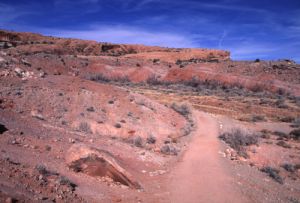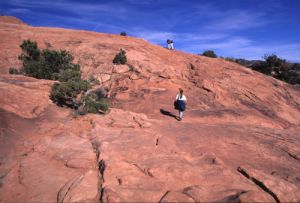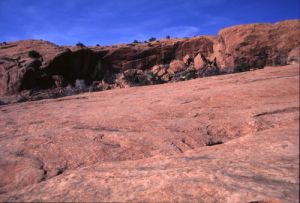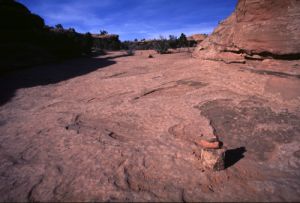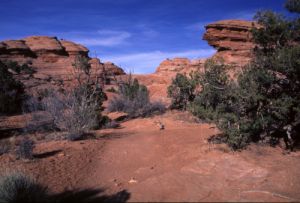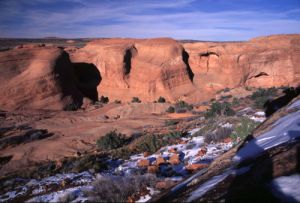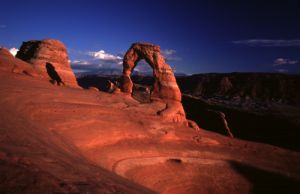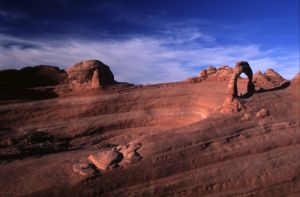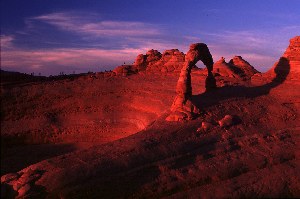 Trips : Utah : Arches National Park : Delicate Arch could very well be called the "signature arch" of the park... even of the state. Many state license plates feature the outline of this famous formation. The hike to Delicate Arch is about 1.5 miles one-way. The most popular time to take this hike is late afternoon so that you can experience sunset at the arch. The trail is marked very well, so you won't need to worry about getting lost on the way back after sunset. You should, however, bring a flashlight and an extra layer of clothes. It can cool down quickly after sunset in the desert. In the summer time be sure to take along plenty of water as well. The hike to the Delicate Arch starts out easy enough. The first portion of the trail is a gravel path, with only a few ups and downs to contend with. As you start out on this trail, you should definitely take the brief side trip to see the ancient petroglyphs of Sheep Rock. It only takes a few minutes, and it's well worth it. The trail will curve around and up and over a few small hills, and will eventually cross the ridge that you see on the horizon. It's not a difficult hike, but it is a bit more difficult than a simple walk. The slick rock can be easy or difficult, depending on the conditions. However, looking to the left it is easy to see why the trail was laid out the way it was. There was a rough ridge that parallels the trail for a while; eventually you will work your way around it. But it is certainly easier to walk on the relatively flat slick rock rather than hike up and over the ridge. One of the fun parts of photography is that you really get used to looking around. Too often we are focused on the destination and not the trip. Hey, that's not a bad philosophy to get through life with, either! After a short hike up the slick rock slopes the trail levels out for a while. The next part of the hike is along the top of a ridge. Here you can see the clear layers of sandstone left behind. If you look close, you might be able to spot a cairn or two. This really isn't a bad hike, at least in seasonable weather. During the winter months there are a few spots that get tricky because of ice. But in the end, it is all worth it. At the end of the trail you turn the corner and there it is. Scenery, jumping out and slapping you in the face. Saying, "Hey, wasn't that last bit of the hike worthwhile?" And truly, it was. This picture is more of the "classic" Delicate Arch shot. In fact, this is the emblem that you will find on many Utah state license plates. Those are the La Sal mountains in the distance. One of my favorite books about Utah contains many pictures by David Muench, and he had managed to take a picture with the full moon through the arch. We were not there at the right time for that. I was later told that the full moon is only visible through the Delicate Arch during the Winter Solstice. In a guide book I had seen a picture of the Delicate Arch from the other side. From this picture, you can't see that there is a steep drop just behind the arch, so there is limited room to set up a tripod. Much less your own feet. So on one trip I decided to retrace my steps and see if I could find a different vantage point to wait for sunset. I went back down the trail and worked my way across the stone looking for a way to see the arch from the other side. Eventually I was successful. I found the perfect spot! There was a nice flat area to set up the tripod, a bit of shelter from the wind, and the fact that there was a sheer drop on two sides all the way down to the valley below didn't bother me a bit! What did bother me was the fact that my water bottle, my wife, and -- most importantly -- all of my camera equipment was still back on the other side of the arch. So I retraced my steps and gathered my equipment. This particular trip was in March, so the ledge was nice and icy. If you are counting, this is the third and fourth time (there and back) that I crossed this portion of the trail. Just before the sun dipped below the horizon, it squeezed in between the mountains and the clouds to send a final blast of crimson light across the landscape. You can see the effects on the picture shown here. Notice how much longer the shadow is than the one up a little higher? This is probably one of the most dramatic shots I have taken. And the crimson color is natural, it was not enhanced during the scanning process. I did take the picture on a special film called Velvia (made by Fuji) that does enhance colors a bit, but trust me, we really did see the glow on the rocks. I snapped about a dozen pictures at different focal lengths, different compositions, and so on while the sun was hanging on the horizon, but this is my favorite. Once the light show was over, we quickly packed up our camera equipment and started down the trail. We had a flashlight, but it was not needed as the twilight sky still provided enough light to see. And the best part: since we had moved, we did not have to cross the icy trail of death again! We have been back to Arches National Park several times since this trip in 1997. However, we have never since been fortunate enough to see the amazing Moment of Light that we captured on film on that first trip.
|
Trips
Themes
Gallery
Techniques
Blog
Site Map
Search
Further Reading
